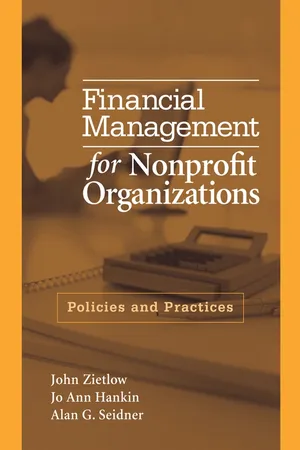Business
Debt Policy
Debt policy refers to the guidelines and strategies that a business uses to manage its debt. It involves determining the appropriate level of debt that a company should take on, as well as the types of debt instruments that should be used. A well-designed debt policy can help a business balance its need for financing with its ability to repay debt.
Written by Perlego with AI-assistance
Related key terms
4 Key excerpts on "Debt Policy"
- eBook - ePub
Financial Management
An Introduction
- Jim McMenamin(Author)
- 2002(Publication Date)
- Routledge(Publisher)
Firms with suitable assets (e.g. land and property) available to offer as security for loans will tend to utilise more debt finance than firms without such assets.Control
Issues of ownership and management control can affect long-term financing policy. If, for example, existing shareholders are reluctant to see their current ownership position diluted by new equity issues they may act in favour of using debt when it comes to financing choices.Alternatively managers may choose debt or equity depending on how vulnerable they view their current positions within the firm. For example, an over-reliance on debt increases the firm's financial risk and similarly the risk of managers losing their jobs if the firm fails.Financial flexibility
As we noted previously some firms may wish to retain cash reserves and spare borrowing capacity to enable them to respond quickly to investment and market opportunities. For example, a firm with substantial cash reserves will probably find it easier to mount a successful takeover bid than a firm without cash reserves. Having cash reserves means that the firm can readily offer cash to the shareholders of the takeover target. This usually makes a takeover offer more attractive to the shareholders of the target company than a straight share swap and increases its chances of success.Growth rates
A company's long-term financing policy is likely to be influenced by its growth rate. For example, a young, rapidly growing company will have a high demand for development finance. In such circumstances the company may limit, or even defer, dividend payments, preferring instead to retain a high proportion of its earnings to finance growth. In addition, a rapidly growing company will typically need to access the financial markets more frequently than slow-growing or stagnating companies, in order to finance its expansion plans.Risk attitudes
The attitudes of managers and owners towards risk will influence corporate borrowing policies. As we know, managers and owners may be risk-averse, risk-indifferent or positively risk-seeking, in which case this will influence their financing decisions. A risk-averse or conservative management will tend to use less debt than their more aggressive or risk-seeking counterpart. - eBook - ePub
Financial Management for Nonprofit Organizations
Policies and Practices
- John Zietlow, Jo Ann Hankin, Alan Seidner(Authors)
- 2011(Publication Date)
- Wiley(Publisher)
Seasonality of revenues can have a tremendous impact on a nonprofit organization’s short-term borrowing requirements. By looking at historic seasonal revenue patterns, a financial manager can obtain part of the picture needed to plan borrowing strategy. In other words, the financial manager must monitor and measure the lag time between the provision of services and the collection of revenues (whether from donations, grants, or fees charged) as well as predict the amount to be collected. Fewer receivables and more payables may dictate that the institution borrow money to see it through the lean months. By analyzing the institution’s cash flow, the financial manager can anticipate this situation and plan accordingly.10.5 STEPS TO SUCCESSFUL BORROWING
Management will be ready to approach potential financing sources after determining strategic objectives and developing a cash flow forecast that indicates the amount of money needed, when it must be borrowed, and when it can be repaid. Before any financial source is approached, however, financial managers must understand:- Debt and what borrowing involves for the organization
- The loan approval process
- The various short-term borrowing alternatives
- The suitability of financing sources versus strategic objectives
- The preparation and presentation of a loan request
(a) UNDERSTANDING DEBT.
Debt is a way of life for most consumers and business organizations. It is interesting to note that borrowing and investing are two sides of the same coin. “Capital” can be defined as the resources that an organization needs to attain a financial objective. There are two broad categories of capital: equity and debt. Equity is money belonging to the organization, and debt is money belonging to another person or organization. Because borrowed funds carry the borrower’s obligation to repay the debt and lenders furnish money for the sole purpose of earning more money, the only differences between debt and equity appear to rest with the person who provides the capital and the return that person seeks. Our focus, since we are dealing with nonprofits, is debt. Our references to the characteristics of equity are to provide a basis for comparison.(i) Risk-Reward Trade-Offs.
Although similarities between debt and equity capital exist, the returns that accrue on each type of funding are very different. Debt capital, in the form of financing received from a lender, generally is priced in terms of an interest rate. Equity capital is “priced” in terms of appreciation of a organization’s stock or assets. For example, small business entrepreneurs often are willing to receive little monetary return in the short run in order to develop a business idea. A nonprofit founder or donor contributing capital requires an in-kind return, namely service provision in line with the organization’s mission. A lender financing the entrepreneur’s dream, however, sees the opportunity quite differently. As a financing source for a risky venture, the lender will expect a large return to compensate for the risk. - eBook - ePub
Lessons in Corporate Finance
A Case Studies Approach to Financial Tools, Financial Policies, and Valuation
- Paul Asquith, Lawrence A. Weiss(Authors)
- 2019(Publication Date)
- Wiley(Publisher)
Perhaps the most important aspect of Debt Policy is deciding what percentage of the capital structure will be debt and what percentage will be equity. The percentage of debt will impact interest coverage, which in turn affects a firm's debt rating. Once the firm decides on the target percentage of debt, then it must decide on the type of debt. The choices include long-term versus short-term debt, fixed-rate versus floating-rate debt, secured versus unsecured, and public versus private debt. The firm must also decide where to issue the debt and in what currency. The first issue in Debt Policy—the percentage of debt versus equity—as addressed by M&M was discussed above and in Chapters 5, 6, and 7, so we will not repeat it here. We should note, however, that AT&T had high, stable cash flows throughout its history. This means its risk when issuing debt was lower, and it should have had a high debt ratio to take advantage of the tax shields. That is, AT&T operations combined with a high debt percentage are consistent with the implications of M&M (1963). The secondary issues—of long-term versus short-term, fixed-rate versus floating- rate, secured versus unsecured, public versus private, market of issue and currency of issue—are not actively addressed in the finance literature. What follows is a discussion of these secondary issues from a practitioner point of view, informed by academic finance. As noted in Chapter 7 on Marriott, what a firm should do is match the maturity of the product market and financing strategies. In that case, Gary Wilson wanted to issue long-term, fixed-rate debt because of his belief that inflation and interest rates would rise. If a CFO has the same expectations as the market, it makes little difference if the firm goes short term or long term. The yield curve prices in the market's expectations of the future - eBook - ePub
Capital Structure and Corporate Financing Decisions
Theory, Evidence, and Practice
- H. Kent Baker, Gerald S. Martin(Authors)
- 2011(Publication Date)
- Wiley(Publisher)
For firms with low debt levels, high liquidity, and low growth opportunities (as in the case of mature firms) managers could undertake negative NPV investment projects for purely opportunistic reasons such as empire building. The origins of managerial overinvestment can be found in the type of decision-making power that allows management to engage in investments for its own benefit. In this case, as Jensen (1986) and Stulz (1990) note, an increase in leverage disciplines management's behavior. In fact, the presence of debt obliges managers to pay interest rates and meet deadlines and thus increases their commitment toward more efficient company management. Although debt offers the benefit of preventing problems of managerial overinvestment, its costs lie on the possibility of exacerbating problems of underinvestment. As Stulz comments, the existence of a trade-off between the costs and benefits of debt thus becomes evident. The benefits of debt would become obvious in how management efficiently exercises its control over firm activity. On the other hand, high debt could increase the risk that the managers may reject positive NPV projects and accept excessively risky projects.As Brito and John (2002) observe, managerial overinvestment and underinvestment concern the quantity of the resources invested in firm activity (i.e., the level of the investment the firm makes, while risk shifting and risk avoidance concern the level of risk that various investment choices can produce. Moreover, in firms that are having financial problems (such as being close to bankruptcy) but that still have high-growth opportunities, incentives for risk avoidance are the main determining factor behind suboptimal investment choices. To the contrary, in firms with low economic prospects, incentives for managerial overinvestment, risk shifting, and underinvestment become dominant, depending on whether the firm is in optimal financial shape (with much available cash) or is in financial difficulty (close to bankruptcy). Therefore, problems of incomplete contracts, information asymmetries, and conflicts of interest among managers, shareholders, and debt holders can give rise to inefficient investment strategies both when there is a high and a low level of debt.CAPITAL STRUCTURE AND CORPORATE STRATEGY: THE ROLE OF NONFINANCIAL STAKEHOLDERSBeside the role of financial stakeholders (shareholders and debt holders) in influencing capital structure decisions and a firm's investment strategy, financial policy is also related to nonfinancial stakeholders. They are the associates of a firm, such as customers, suppliers, employees, and the community in which the firm operates, who have no direct monetary stake in the company and no direct influence on the firm's financial policy (no decision or voting power). Nonetheless, they have a stake in the firm's financial health. Nonfinancial stakeholders are interested in the firm's financing choices because they can be hurt by its financial difficulties. Specifically, a firm's capital structure choices can affect nonfinancial stakeholders by affecting the probability of default on their explicit and implicit claims on the firm and by influencing the firm's production and pricing decisions. Consequently, firms may be forced (implicitly) to take the interests of their nonfinancial stakeholders into account in formulating financial policy.
Index pages curate the most relevant extracts from our library of academic textbooks. They’ve been created using an in-house natural language model (NLM), each adding context and meaning to key research topics.



